
Colombia is a land of plenty, one of the most biodiverse in the world, awash with rivers, filled with fertile lowland and highland areas – in an overall area about 50% larger than Texas and with a population of about 50 million.

We spent the first third of our visit to the country above 1500 meters in altitude, within the three fingers of the Andes that trisect the country. Great rivers like the Magdalena fill the high valleys, accommodating for centuries the native tribes, Spanish colonializers, and contemporary farmers of corn, coffee, potatoes, beans, grapes, pineapples, plantains, cattle and so on.

Though close to the Equator, the climate is uniform and pleasant, with lows at worst 5 and highs 25. Clouds gather regularly with the waters of the Pacific or Caribbean. Rains come but last just a few hours. And it is spectacularly beautiful with lush hillsides and mountains, plus limestone formations covered with diverse trees and plant life, draped around farmlands that seem ever green. Some of these, just at the right altitude of around 1500 to 2000 meters, are the premier coffee growers of Colombia, one of the big three producers along with Brazil and Vietnam.
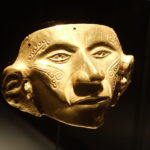
Other resources fill these high valleys, including a wide array of minerals and ores. Gold was treasured by the indigenous tribes all over Colombian territory, as far back into pre-history as tribes learned how to work with the metal. From gold, they made jewelry for the important social set as well as ceremonial and sacramental objects. At the Museo de Oro in Bogota, we were able to see a remarkable collection of these objects dating back 2000 years, and learn about the cultures that made them. We were particularly intrigued to see how similar were the uses of the gold across the many indigenous tribes, but also how varied their styles could be.
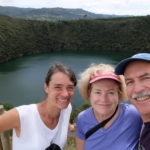
Gold seduced the Spanish eventually and brought them to Bogota. From this base, they forced the natives to work in the nearby valleys, mining and panning for gold riches the Spaniards could haul back to Spain. There the gold could adorn the wealthy, and somewhat ironically be made into ceremonial pieces for the church. Near here, out of Guatavita some 75 kilometers away, one of the various legends of a city of gold emerged, an El Dorado.

The legend supposedly began from misunderstanding of what the Spanish were told about a ritual celebration by the local natives there. The Muisca people were attuned to the spiritual presence within nature, as many surviving records of their ideas demonstrate. In the Guatavita ritual, the chiefs and shamans would give thanks to the earth and the gods for their bounty by returning some of the gold to nature. After sufficient hallucinogens and stimulants, they would launch a raft on the several kilometer wide oval lake at Guatavita and ceremoniously toss the gold into the waters. The Spanish virtually enslaved the tribes to try and excavate the lake, as well as extract gold from the valleys.
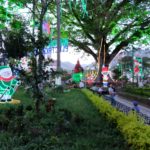
Meanwhile they brought their religion and spread the word far and wide in all of Latin America. Colombians remain a very religious people, never more so than at the two major holidays of the year, Christmas and Easter. At Christmas time, even the smallest village lights up with decorations and illuminated fixtures. Masses proceed throughout the day. The big cities host a huge party before the 25th of December, and then really let loose for the Feria in the week after. Oddly some of the best known of these occur in those cities notorious for other reasons, Medellin and Cali, former homes of the drug cartels.

We were not around for Easter, but we did visit Popayan, the “White” city whose celebration of the holiday dates back over 450 years and is recognized as a World Heritage event. We were told how astonishing are the processionals through the streets that honor the last stages of Christ’s life, as many people join the procession and many others throng the punch-out balconies to admire the scene.

The entire town, over 10 blocks square, consists of two-story colonial buildings outfitted appropriately all in white, plus some gold trim. Throughout the year, these are painted anew so the place gleams at the Easter festival. Just walking the streets at other times of the year is impressive enough. No signs are allowed perpendicular to the walls, but must be discreetly flat on them…in gold, of course.
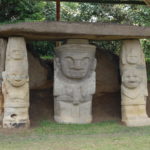
The Spanish were not so interested in another treasure now attracting tourists to the southern highlands of the Andes around San Agustin and Tierradentro, the latter so named because it was a place you need not go. And they disdained native religious practices anyway.

From 2000 to 1000 years ago, during what is now called the Classical Period of Pre-Columbian art, however, tribes in these areas built impressive tombs. Though home to many living farmers scattered across a wide territory, these areas are sparsely populated. The attraction for visitors is the land of the dead.

In the area of San Agustin, the world’s largest necropolis, the ancient peoples built stone casitas for graves and protected these with menacing, quasi-human figures carved out of rock, from the hobbit-sized (1 meter) to the gigantic (3 meters). Then they moved mountains of earth to enclose the tombs. or completely reworked the landscape to sanctify it.
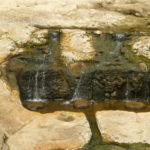
These tribes transformed nature for their rituals as well, most notably at Lavapitas in San Agustin. On a gently sloping rock face within a flowing stream, they carved a myriad of figures, including shamans, snakes, squirrels, and other animals. Niches defined a hierarchy where ritual participants sat as the water flowed. One niche packed in three small figures: a squirrel on the right, a guardian figure to its left and then a priestly invocation just to its left (signalling goal!).

In a somewhat later period, in Tierradentro, others entombed their dead in a different style by digging burial chambers 2 to 3 meters high out of solid tufa rock, and decorating them with geometric patterns and images. We descended into chamber after chamber on narrow steps originally formed by the builders – moving from plateau to plateau to do so, on a strikingly beautiful mountain slope that comprises the archeological park.
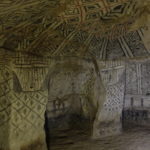
Most of the contents are back in museums, but the chambers themselves are impressive.
In the 18th century, the tombs became notorious as reportedly gold and jewels adorned them. Vandals and thieves descended, damaging much, but found little of value there. In the last hundred years or so, the historical and cultural value has become significant – and deserving of the World Heritage status granted to them.

As for the tribes themselves, they disappeared even before the Spanish arrived, leaving no other traces – for reasons not at all clear to archeologists. But the artistic achievement and the engineering capability they demonstrated is quite clear because of what they left behind for us to see.
Much later in the 19th century, when the Spanish were sent packing, the colonial people – now a mix of Spanish and indigenous stock – exploited themselves. Dictators and corrupt leadership were part of the legacy the colonializers left behind, and once again the rich resources energized the few to take power and gain from it.

In the late 20th century, decades of civil wars created more and more hardship. At one point, downtown Bogota went up in flames as rival political factions squared off. That helped push the wealthy north out of the central city. To make matters worse, another resource, those hallucinogens used by the native tribes, bred drug cartels in the big cities, gangs that profited, often violently, from the habits of North America and endangered this country.
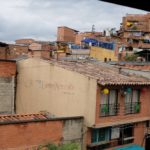
By now, almost all of this internal warfare is finally ended, through some enlightened leadership and normalizing of government operations. In the two decades from the mid-1990s on, vast areas of farmland once war zones have become just plain normal. Poor city districts once overrun by drug trade, like the hillside communities of Popular 1 to 3 and Santo Domingo in Medellin, have become productive and safe within just a dozen years of hands-on attention by the leadership. Among other steps, it ensured good public transport up the hills by building sleek tramways.

The most recent success, somewhat symbolic now that the country has turned to a saner path but important to Colombians, was the completion of a peace treaty ending the internal war with FARC. This was the guerilla force that remained most powerful in the country. The Nobel Peace prize awarded for this treaty to Colombia’s president (who is donating the funds for the good of the people) was as much an award to the country because it has progressed so far.

Still in downtown Bogota, you can feel as if you are not quite fully in a state of peace. There are security personnel with dogs patrolling all over the streets, and extra security for virtually every building. The local Oxxo, a 7-11 type convenience store, had a door guard armed with an automatic weapon and buying a beer required an employee to unlock the cooler. But otherwise you could think you were in any convenience store in the United States.

The throngs of people that pass along the downtown streets don’t seem particularly concerned, and locals seem indifferent. Life, study, commerce – and often horrific traffic – proceed as in any city. New construction, good cars, expensive restaurants or bars, and well-dressed people all demonstrate a burgeoning economy. The charming low-lying buildings of Bogota’s old La Candelaria district and other inner city neighborhoods complement these signs of rebirth. Perhaps those outward signs of safety and security remain just to remind everyone of how things have improved and assure us all that it will continue this way.
Nor is exploitation all in the past. Oil and gas are today’s liquid gold, and sadly modern corporations and government still aim to despoil the land for short-term economic gain and trample some of the people to do so. There are many, many displaced farmers who are pressured to give up their lands for modern extraction. They struggle to find their way and make a living in the big cities, often homeless and with few resources to survive.

So today, among the 9 million or so inhabitants of Bogota, a great divide often separates the rich and poor. This is even a geographical divide here, as the wealthy mostly live in the north of the center of the sprawling city, a shift caused at first by the political chaos, while the poor continue to extend to the south. Though we stayed in La Candelaria, we drove north along the mountain range that provides both a gracious backdrop to the city and a source of fresh water. Along the way, the buildings become more and more vertical, creating canyons of secure apartment homes and developments for those who can afford it. You could think you were cruising the ritzy sections of LA’s Beverly Hills.

But even in this regard, enlightened leadership has begun to make a difference. We were intrigued and pleasantly surprised to learn about the Levels system of paying for services within the country. Each resident falls into one of six levels of wealth, defined primarily by annual income. The people in level 1 pay a tiny amount for the same benefits that level 6 people pay a lot for. So a liter of water, say, at level 1 might cost a few pesos, but a hundred times that at level 6. Similarly, other services such as health care costs and education are priced on the same graduated scale. The Bogotans that we spoke to about this all seemed quite pleased with the fairness and the communal spirit encapsulated by the system, though admittedly some like the homeless need different attention. A level 5 person we met was just as pleased as a level 2 person. Your economic status in Colombia no longer limits your opportunity or your care.
It seemed to us that the highlands, the high valleys and all the lowlands of Colombia, were on the upswing. And their people had a good chance to continue living safely, productively and more and more prosperously into the future. Colombia’s topography will still have its many levels, but its economy should surely prosper from its efforts to level modern economic disparity.
(Also, for more pictures from Colombia, CLICK HERE to view the slideshow at the end of the itinerary page.)


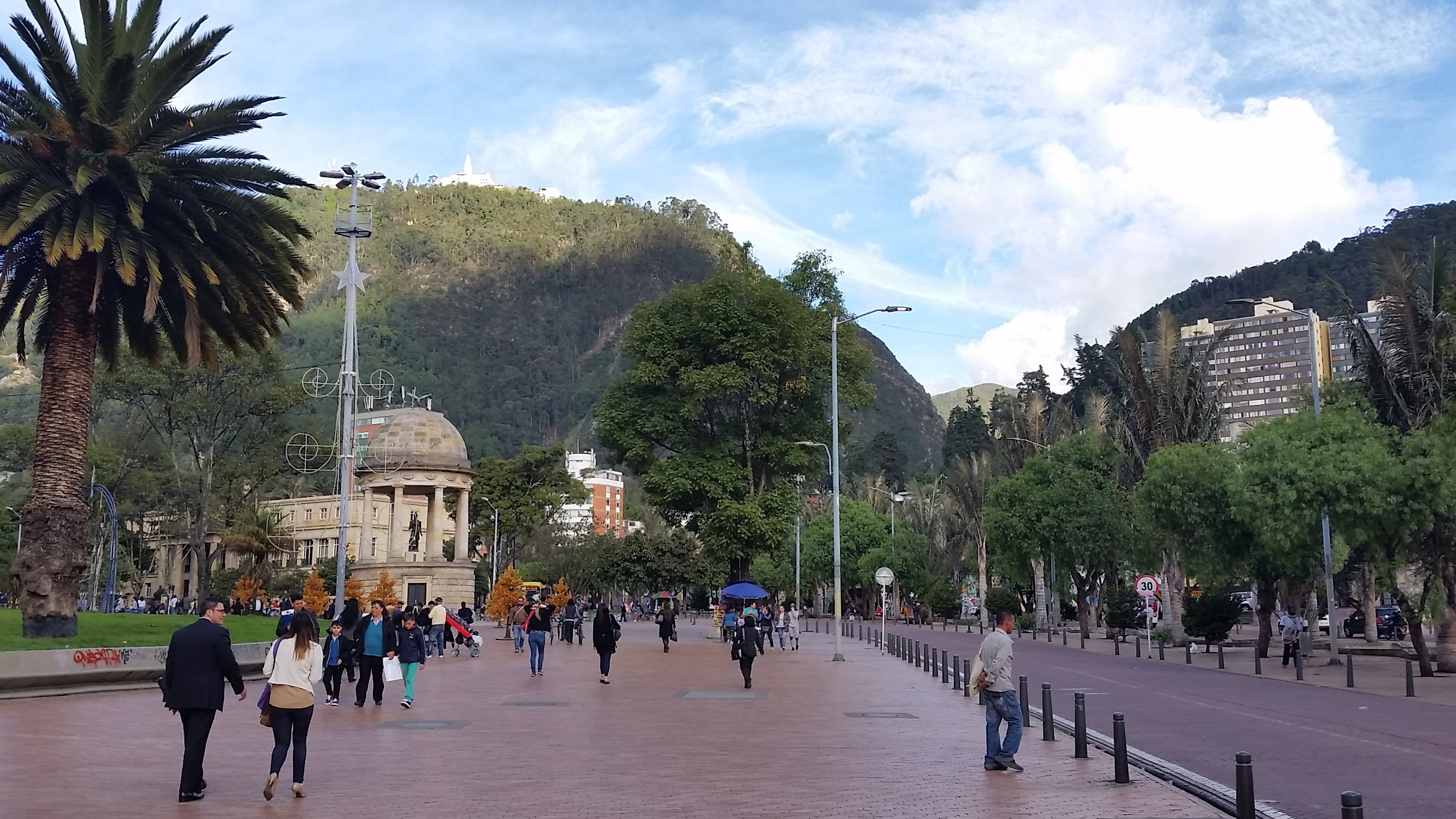
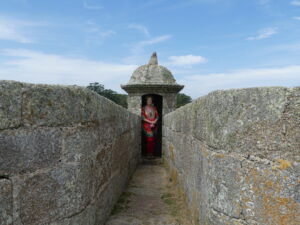
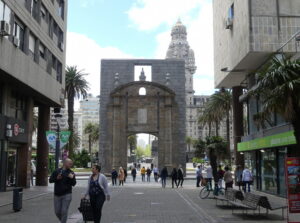
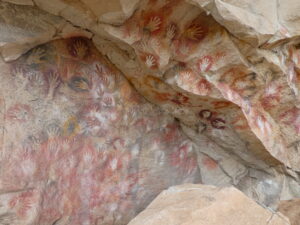

did you take the gondola?
Of course. It’s just like a gondola on the ski slopes, but without the boots. You can’t take that photo unless you’ve already gone to the top. There, we even met a few Floridians whose families came from the country of India…and were drinking local beer after wandering about these streets. Pleasantly, it’s now just a regular neighborhood of kids, shops and residences.